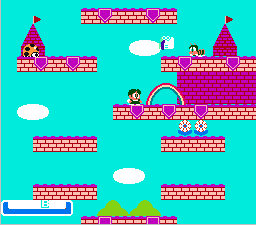 Platform: NES
Platform: NES
Developer: Taito
Publisher: Taito
Release Date (NA): 1991
Genre: Platformer
Rating: 7.5 out of 10
Reviewed by: Solo Joelo
Rainbow Islands, released on the NES in 1991, is billed as “The Story of Bubble Bobble 2”. However, it’s not a direct sequel to the original Bubble Bobble game – it would be more appropriate to call it a spiritual successor. The main characters are the same, except in human form (if you haven’t played Bubble Bobble, they are humans that have been turned into dragons in that story). Yet, the game itself is completely different. Bubble Bobble is unique, and while Rainbow Islands takes a bit more of a traditional platforming approach, it still has a very particular feel.
There isn’t much of a story to Rainbow Islands – collect treasure, beat the game, and you win a whole pile of treasure. Simple enough, except that there is an extra mechanic to the story. You must collect a gem representing every color of the rainbow in order to get a more satisfying ending. If you don’t do this, the game will tell you that “something doesn’t feel right” while you’re sitting atop your gigantic pile of treasure. Whichever way you choose to play it, this story design gives the game a replay value that is absent from a lot of platformers.
 The gameplay is truly where Rainbow Islands shines. Your character creates rainbows that act as a weapon and an extra platform. Once you get enough points, your rainbow is upgraded and you can create two simultaneous rainbows. You can walk up onto the rainbow, but if you jump on top of them they fall down the screen, destroying any enemies in their path. In later levels, there are creatures that can quickly follow you up your rainbows.
The gameplay is truly where Rainbow Islands shines. Your character creates rainbows that act as a weapon and an extra platform. Once you get enough points, your rainbow is upgraded and you can create two simultaneous rainbows. You can walk up onto the rainbow, but if you jump on top of them they fall down the screen, destroying any enemies in their path. In later levels, there are creatures that can quickly follow you up your rainbows.
This gives the game a fast-paced and unique feel, in addition to creating additional challenges the further you are along. Even if you get into a routine of just using your rainbows to quickly glide up the screen, once you progress far enough this tactic will no longer work, causing you to adjust your gameplay style. The game does this because once you reach the final boss, you must use every tactic you’ve learned in order to beat it. In this aspect, Rainbow Islands has nearly perfect gameplay – it lets you learn on your own as you go along without having to explicitly tell you which buttons to push or how to do something new like a lot of modern games.
Rainbow Island’s atmosphere has a very strange feel. Not to spoil it, but the seventh island has kimono houses with giant geisha heads attached to tentacles inside that can easily kill the player if the timing of your jumps is even slightly off. It gets progressively darker, and the “mechanical” island is quite creepy with minimal sounds – just out-of-tune bleeps and bloops that are in stark contrast to the cutesy feel of the first couple of islands. The score serves its purpose – it’s just kind of there, apart from the “mechanical” island, where the minimal sounds produce a very cold atmosphere. Luckily, no part of the soundtrack of game sounds are annoying enough to be detrimental to the game.
If you are of the opinion that the platforming genre is worn out, Rainbow Islands is such a unique and downright fun game that it will change your mind. The increasing difficulty and the “extra ending” aspect of the story will appeal to hardcore gamers while the fast-paced gameplay and pleasant look of the graphics will appeal to even the most casual of gamers. It’s one of the games where you’ll spend hours playing because it does get rather difficult towards the end, but even if you don’t beat it you’ll still enjoy yourself.



